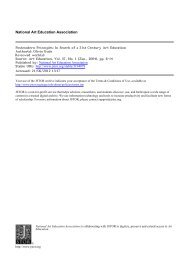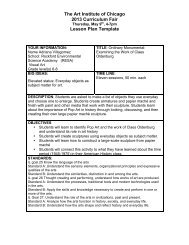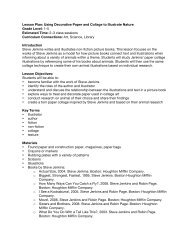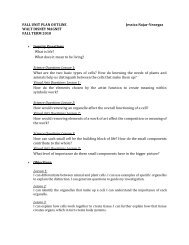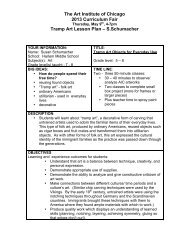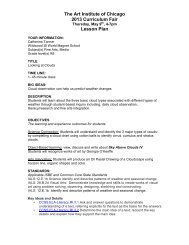Lesson 1 - LearningThroughMuseums
Lesson 1 - LearningThroughMuseums
Lesson 1 - LearningThroughMuseums
You also want an ePaper? Increase the reach of your titles
YUMPU automatically turns print PDFs into web optimized ePapers that Google loves.
Day 3: Communicating about Places with Symbols<br />
● Time Allotment<br />
60–75 minutes<br />
Note: Preview the lesson and decide if you want to expand the map-making activity by providing<br />
additional materials such as yarn and tape to physically connect points on a map or add borders. If<br />
not, the materials listed below will be sufficient for this portion of the lesson.<br />
● Materials<br />
Materials for each student:<br />
Plain white 8 ½” x 11” paper<br />
Pencil<br />
Colored markers, pencils, or crayons<br />
Copy of Pre-Planner organizer<br />
Copy of Map Maker organizer<br />
Copy of Words and Writing organizer<br />
Fiction or non-fiction texts that include descriptions of a place (you may use books from the<br />
SCRMA or another series or trade books from the classroom or school library)<br />
● Advance Preparation<br />
• Prepare to display the reproduction of Hanging Entitled “Map of the Middle West” in<br />
the classroom for student viewing.<br />
• Review the Background Information section of this lesson about Hanging Entitled “Map of<br />
the Middle West.”<br />
● Vocabulary<br />
compare<br />
contrast<br />
fiction<br />
map key<br />
plan<br />
● Procedure<br />
1. Demonstrate how to make a map by making one on the chalkboard. Choose a familiar place to<br />
map. It can be a real place or a fictional place such as a place they read about.<br />
2. First, list things you want to show about the place. Remind students of the kinds of things that<br />
Hanging Entitled “Map of the Middle West” shows about the United States. Then ask students<br />
to suggest symbols that could stand for those parts.<br />
3. Make a map key. Put the symbols in the key and note what they represent.<br />
4. List different places students can represent with maps. Set up the list in two columns, fictional<br />
and real. Ask students to suggest places.<br />
5. Give each student the Pre-Planner organizer. Ask them to choose a place to show in their map.<br />
They can work individually or with a partner. They should complete the Pre-Planner first and<br />
then create the map. Encourage students to be creative.<br />
Art Institute of Chicago • 111



